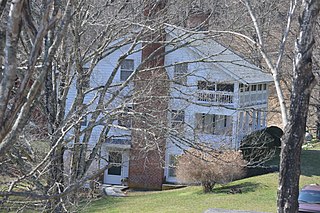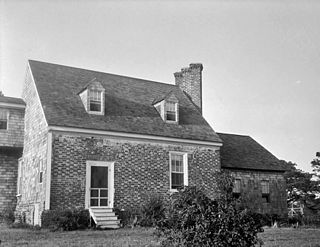
Nickelsville is a town in Scott County, Virginia. The population was 378 at the 2020 census. It is part of the Metropolitan Statistical Area, which is a component of the Johnson City-Kingsport-Bristol, TN-VA Combined Statistical Area – commonly known as the "Tri-Cities" region.

The Bollinger Mill State Historic Site is a state-owned property preserving a mill and covered bridge that pre-date the American Civil War in Burfordville, Cape Girardeau County, Missouri. The park was established in 1967 and offers mill tours and picnicking. It is managed by the Missouri Department of Natural Resources. It includes the Burfordville Covered Bridge, which is listed on the National Register of Historic Places.

George Washington's Gristmill was part of the original Mount Vernon plantation, constructed during the lifetime of the United States' first president. The original structure was destroyed about 1850. The Commonwealth of Virginia and the Mount Vernon Ladies’ Association have reconstructed the gristmill and the adjacent distillery. The reconstructed buildings are located at their original site three miles (4.8 km) west of the Mount Vernon mansion near Woodlawn Plantation in the Mont Vernon area of Fairfax County. Because the reconstructed buildings embody the distinctive characteristics of late eighteenth century methods of production and are of importance to the history of Virginia, the site is listed on the National Register of Historic Places despite the fact that the buildings are not original.

St. John's Church is a historic Episcopal church located near Sweet Hall, King William County, Virginia, United States. It was constructed in 1734 and is a one-story, T-shaped brick building. It measures 50 feet, 3 inches, by 20 feet, 2 inches, with a 24 feet wide, 28 feet, 9 inch, wing. St. John's is the only surviving colonial church in King William County to remain in the Episcopal charge. This church is also important in that it is associated with Carter Braxton, Signer of the Declaration of Independence, who regularly attended worship there.

Providence Presbyterian Church is a historic Presbyterian church located near Gum Spring, Louisa County, Virginia. It was built in 1747, and is a two-story, three-bay, wood-frame building measuring 50 feet, 3 inches, by 26 feet, 4 inches. It is one of the few frame churches in Virginia remaining from colonial times and was one of the first Presbyterian churches to be built in the central part of the state. Samuel Davies served as its first minister until 1759, when he assumed the presidency of Princeton University. A distinguished son of the church was Robert Lewis Dabney, noted mid-19th century Presbyterian minister and church architect.

Greenville is a historic plantation home located near Raccoon's Ford, Culpeper County, Virginia. Building of the property commenced in 1847 and was completed in 1854. It is a three-story, central-hall plan Classical Revival style brick dwelling. It measures 54 feet by 38 feet, 8 inches, and has a low pitched, W-shaped, ridge-and-valley roof. The front facade features a three-story portico with Tuscan order, stuccoed brick columns. Also on the property is a contributing outbuilding.

Woodville School is a historic Rosenwald school building located at Ordinary, Gloucester County, Virginia. It was built in 1923, and is a high one-story, five-bay, symmetrical frame structure. It measures 63 feet, 6 inches, by 28 feet, 6 inches, and sheathed in white painted clapboard. It was converted to residential use after 1942. Also on the property are a contributing guesthouse or additional school building and a small shed.

Brookside Farm and Mill is a historic grist mill and farm complex located at Independence, Grayson County, Virginia. The Brookside Mill was built in 1876, and is a three-story, three-bay by three bay, heavy timber frame building measuring 30 feet by 35 feet. The principal dwelling was built in 1877, and is a two-story, three-bay, frame building with a central passage plan. Other contributing buildings and structures include a brick spring house, brick smokehouse, log corn crib, frame hen house, miller's cabin, the miller's cottage or Graham House, a frame service station / garage (1918), and concrete dam (1914) and earthen mill race.

Fork Church is a historic Episcopal church located near Ashland, Hanover County, Virginia. It was built in 1736, and is a one-story, gable roofed brick building. It measures approximately 34 feet by 74 feet and has walls 22 inches thick. The front facade features a small pedimented porch supported on square brick columns, both probably added in the early-19th century. Also on the property is a contributing church cemetery. Among the more-notable persons who often attended services at Fork Church were Patrick Henry, Dolley Madison, and the novelist Thomas Nelson Page. From 1893 to 1903, Fork Church's rector was the Reverend S. S. Hepburn, grandfather of actress Katharine Hepburn.

Meems Bottom Covered Bridge is a covered bridge in Shenandoah County, Virginia, United States. The bridge, at 204 feet (62 m), is the longest covered bridge in Virginia and one of the last that supports regular traffic. Near the town of Mount Jackson, the Meems Bottom Covered Bridge features a 200-foot single-span wooden Burr arch structure. Built in 1892 by Franklin Hiser Wissler, the wooden bridge over the North Fork of the Shenandoah River provided access to his apple orchards at Strathmore Farms. The bridge was listed on the National Register of Historic Places on June 10, 1975.

Winona is a historic home located near Bridgetown, Northampton County, Virginia. It dates to about 1681, and is a small, 1+1⁄2-story, brick structure with a gable roof. It measures 32 feet, 6 inches, by 27 feet 6 inches. It features an exterior end chimney with three free-standing stacks set diagonally on the base.

Cockram Mill is a historic grist mill complex located near Meadows of Dan, Patrick County, Virginia. The mill dates to about 1885, and is a two- and three-story, rectangular frame building on a concrete foundation. It measures 111 feet by 24 feet and is located adjacent to a concrete dam on the headwaters of the Dan River. The mill is operated by two metal turbine wheels, 14 feet and 16 feet in diameter. Associated with the mill is the contributing miller's house built about 1921.

Yates Tavern, also known as Yancy Cabin, is a historic tavern located near Gretna, Pittsylvania County, Virginia. The building dates to the late-18th or early-19th century, and is a two-story, frame building sheathed in weatherboard. It measures approximately 18 feet by 24 feet and has eight-inch jetty on each long side at the second-floor level. It is representative of a traditional hall-and-parlor Tidewater house. The building was occupied by a tavern in the early-19th century. It was restored in the 1970s.

St. Luke's Episcopal Church is a historic Episcopal church in Fine Creek Mills, Virginia, United States. It was built in 1843–1844, and is a one-story, Classical Revival style brick church building. It measures 20 feet wide by 36 feet deep, and features a pedimented front gable roof.

Farnham Church is a historic Episcopal church located at Farnham, Richmond County, Virginia. It was built in 1737, and is a one-story, cruciform shaped brick Colonial era church building. It measures 63 feet, 8 inches, feet by 58 feet, 2 inches, and is topped by a gable roof. Two years into the War of 1812, bullet holes were left in the walls during a conflict between the Virginia militia and the British fleet, led by Admiral George Cockburn. This event was called the Skirmish at Farnham Church. During the Civil War the church was used by Union soldiers as a stable. The church was last renovated in 1921 in the Georgian Revival style.

Hays Creek Mill, also known as McClung's Mill, Patterson's Mill, and Steele's Mill, is a historic grist mill located near Brownsburg, Rockbridge County, Virginia. It dates to about 1819, and is a 2+1⁄2-story, rectangular wood-frame building on a limestone basement. The building measures 35 feet by 45 feet and retains an iron overshot wheel measuring 15 feet in diameter and 5 feet thick. Associated with the mill are the contributing miller's house, garage that once served as a corn crib, and cow barn. The Hays Creek Mill remained in operation until 1957 in a number of capacities as a grist, saw, and fulling mill.

Breneman-Turner Mill is a historic grist mill located near Harrisonburg, Rockingham County, Virginia. It was built about 1800, and is a 2 1/2-story, Federal style brick building. The building retains its water wheel, measuring 16 feet in diameter and 5 feet wide, and three sets of burr stones. The mill survived General Philip Sheridan’s burning of the Shenandoah Valley in 1864, and remained in operation until 1988.

Quarters 17, also known as Building 17, Lee's Quarters, and the Tuileries, is a historic officer's quarters located at Fort Monroe, Hampton, Virginia. It was built in 1823, and is a two-story, six-bay, brick building with a rear ell in the Federal style. It has a three-story full façade front Tuscan order porch on both the first and second level. The building was renovated and the porch was added in 1907. The main section measures 65 feet wide, 37 feet, 9 inches deep, with an 18 by 23 feet rear ell. The original design was for housing eight junior officers, with later alterations to accommodate four families. It is one of two identical four family brick officer's quarters known as the Tuileries. Robert E. Lee moved to Fort Monroe in 1831 with his young bride into two rooms that formed a wing of the west side of Quarters 17. He resided there until November 1834.

Causey's Mill is a historic grist mill located in Causey's Mill Park at Newport News, Virginia. It was built in 1866, and is a small two-story wood-frame building originally supported by a brick and concrete foundation. It retains its original machinery and is one of the two last surviving grist mills on the Peninsula. The mill operated until nearly the 20th century. In 2011, the mill was moved about 75 feet from its original location away from the shore of the Mariners' Lake and set on a new foundation.

Southern Stove Works, Manchester is a historic factory complex located in Richmond, Virginia that replaced the company's original factory. The complex includes two contributing prefabricated steel frame buildings built in 1920. The west building contains the original two-story office building that has been connected by one-story infill to the long one-story warehouse building that contained the pressing and mounting departments and a three-part warehouse. The office is a five-by-three-bay, two-story, building measuring 40 by 80 feet and brick curtain walls. The east building today consists of the foundry with attached original washrooms and office, charging room, and an expanded mill room.






















